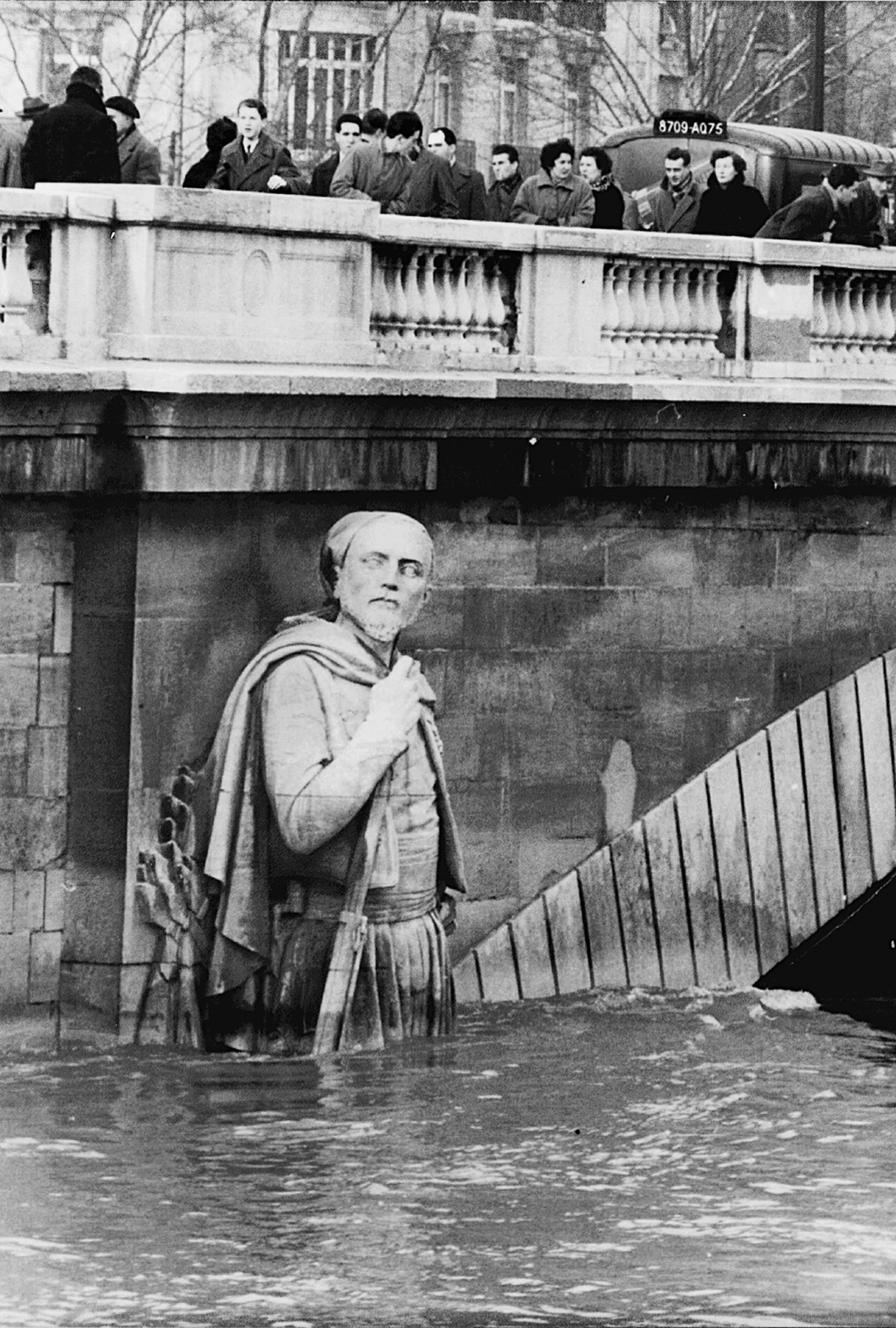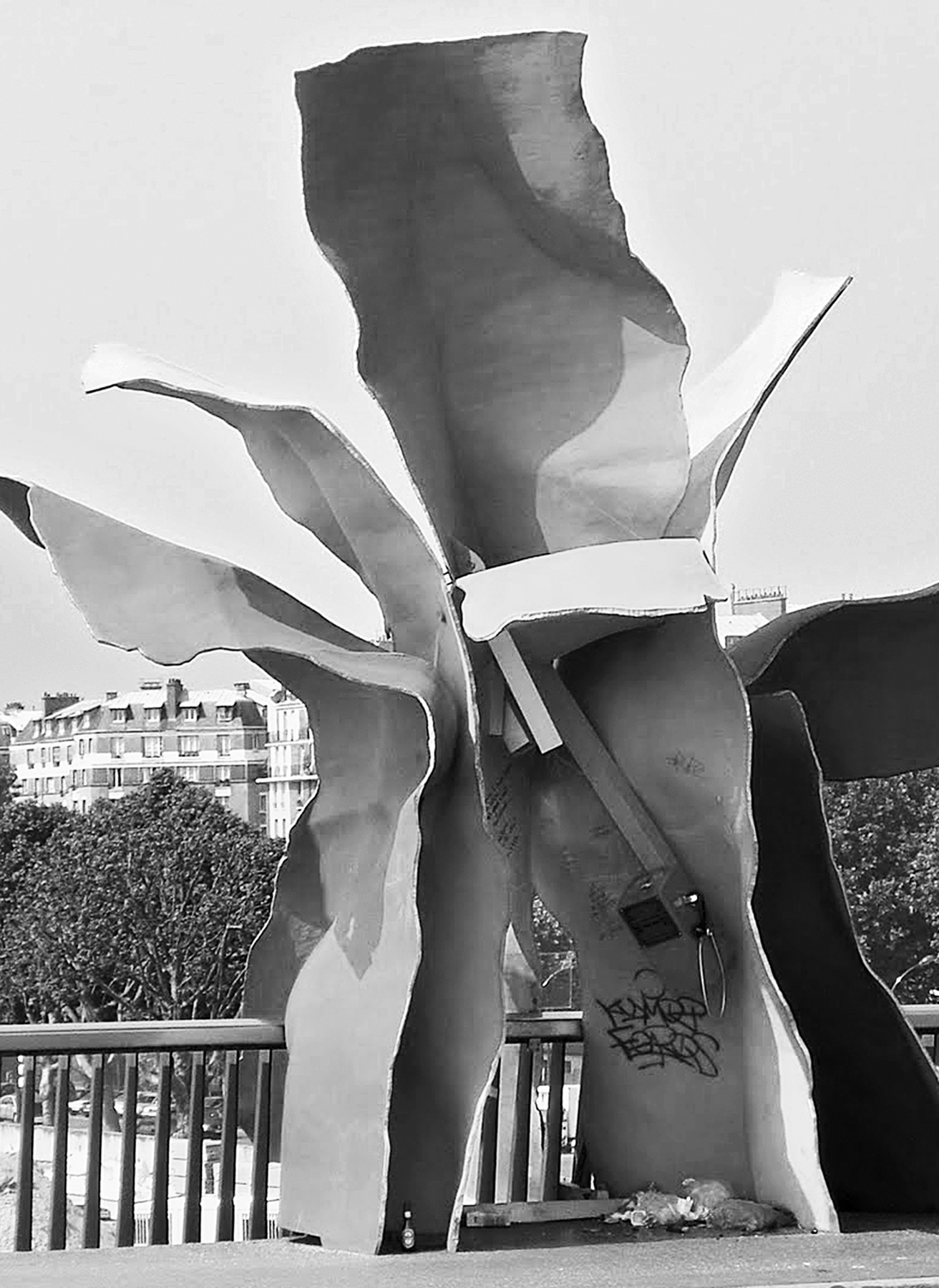Paris 6me. January 2018. 3 a.m. Rain all week, a silent drizzle, shining the metal roofs of the city grayer; a rain invisible at night but audible in the tattoo of fat drops falling six stories from the gutters to smash on the courtyard cobbles. Out of sight but less than a kilometer away, the Seine rises, invading the bankside promenades.
FEBRUARY 2018, AND THE SEINE HAS SELDOM BEEN HIGHER. OF the bridges under which scores of barges and pleasure boats pass daily, only a narrow space remains above water. Beneath the Pont de l’Alma, the seventeen–foot statue of a Zouave, a rifleman from a North African regiment, stands resolutely on guard. When the waters are high Parisians say, “The Zouave’s feet must be wet.” Today, they lap his beard.
Friends overseas email, “Are you all right? Have the floodwaters reached you yet?” Wondering if they know something I don’t, I go out on the terrace and look down six stories into our street. No water there except on the wet pavement, where sanitation workers hose it down in their twice–weekly tour.
After lunch, I take a walk down to the river. Streets on the southern, or left, bank of the Seine are at little risk of being flooded. Rising from the river to the long ridge of Montparnasse, the ground here is mostly the sandstone that has been quarried for centuries to build the city.
People on the right bank are not so fortunate. A flat river basin, its clay soil and a high water table make it prone to flooding. Engineers constructing the Opéra in the 1860s had to run pumps day and night to keep the foundations dry. When they stopped, water seeped in, inspiring the legend that a lake lay under the building across which a mutilated musical genius—the phantom of the Opéra—poled.
Looking at the Seine today, I can believe such myths. In yellow–gray spate, the water is inching up the stone wall toward street level. The previous year, the town hall posted online an alarming computer simulation of what would happen if it spilled over. Not only the metro stations and underground parking garages would flood, but so would the basements of the Grand Palais and the Louvre.
It had happened before. In January 1910 the Seine rose eight meters, only three more than today, invading even the lower streets on our side of the river. The river didn’t need to brim its banks. Once rain filled the sewer and stormwater outlets, pressure from the river acted as a pump, sending water spouting out of manholes and drains. Markers on older buildings indicate the level reached by la crue de la Seine du 28 janvier 1910: anything from knee to shoulder height. There’s an element of bravado in such memorials. You think your river floods? Take a look at this!

The Zouave on the Pont de l’Alma.
The Zouave by Georges Diebolt on the Pont de l’Alma. Photograph by the author.
For a time, the writer Anaïs Nin lived on a houseboat, La Belle Aurore, moored on the right bank. Enamored of water and journeys, Nin fancied herself on a cruise without end, with new adventures forever floating downriver toward her. “Once inside the houseboat,” she wrote, “all the voyages began. Even at night with its shutters closed, no smoke coming out of its chimney, asleep and secret, it had an air of mysteriously sailing somewhere.” But weather is no respecter of literature. Today, her former mooring is lost under a racing torrent.
Confined between stone walls, the Seine here is unrecognizable as the same river it is upstream, where the water is free to find its own level. Novelist William Wharton, who also lived on a houseboat—moored at Le Port–Marly, about twenty kilometers outside the city—returned from a weekend away to find the river in flood:
The beautiful black or green Seine is a raging yellow muddy river now; it looks like the Amazon, with rippling waves as the water courses along its rampaging way. It has covered the island across from us so that it looks like one huge wild river with whitecaps all the way to the bank on the other side of the island. Our neighbors are running around like crazy people, fastening things down and cursing us for abandoning our boat.
Wharton and his houseboat survived, but each time the river runs high it carries fragments of shattered lifestyles downstream. During the high water of 2018, the staff of the riverside Shakespeare & Company bookshop warned customers to expect the
bizarre and revealing sight of the quays strewn with all the manmade flotsam and organic life that is usually borne through the city and downriver beneath the glaucous, roping waters, unseen by us surface dwellers. Stranded items spotted near the bookshop in June 2016 included an ornate wingback armchair, countless tons of riverweed, and a full peloton [platoon] of algae–furred bicycles!
The rushing torrent seemingly just under my feet, I cross the Pont des Arts, the fragile–looking metal bridge on stone piers that leads to the Louvre. Of the thirty–seven bridges that suture one half of Paris to the other, this one is most richly encrusted with emotion. It takes the form of cadenas d’amour: “love locks.” Couples write their names on a small brass padlock, attach it to a security barrier, and toss the key into the river. So many cadenas accumulated on the Pont des Arts that barriers tore loose from their weight. In 2015 the city removed forty–five tons of locks and replaced the metal mesh with glass, but the fad still flourishes.
Cross any bridge over the Seine and there’s a brief sense of hovering between worlds. To Guillaume Apollinaire, the bridges’ wayward characters and tendency to develop personalities of their own recalled sheep. In his poem “Zone,” he wrote, “Shepherdess O Eiffel Tower this morning the bridges are bleating.” The image of indiscipline reflects the bridges’ ambiguous status; technically belonging to Paris, they are administered and maintained by the state as part of the patrimoine.
Filmmakers often use Paris bridges to imply links between different worlds. In Last Tango in Paris, Marlon Brando and Maria Schneider independently cross the unglamorous Pont de Bir–Hakeim, which celebrates a little–known battle of 1942, en route to the soulless, bourgeois apartment where they have their erotic encounters. For Munich, Steven Spielberg imagined the same bridge hosting a produce market, where the Mossad assassin played by Eric Bana meets Mathieu Amalric to bargain for information while doing the weekend shopping. Bana, a keen cook in the film, advises Amalric on seasonal vegetables as they discuss political murder—shorthand for the banality of contemporary terrorism.
Cary Grant and Audrey Hepburn pass under this and a dozen other bridges during their nocturnal rendezvous on a bateau mouche in Charade. The operator spices up that voyage by spotlighting lovers as they cuddle and grope along the stone–paved riverbank, the same one where Gene Kelly dances with Leslie Caron in An American in Paris to “Love Is Here to Stay” and Goldie Hawn defies gravity to float above Woody Allen’s head as she sings “I’m Through with Love” in Everyone Says I Love You. All underwater now. Fortunately romance isn’t soluble.
One of the stranger works of transpontine art was the 2006 collaboration between conceptual artist Sophie Calle and architect Frank Gehry. It took the form of a plastic telephone booth resembling, typically for Paris, a gaudy, exotic flower. It stood on the Pont du Garigliano, one of the less stylish bridges (though, because of its height of eleven meters above the water, popular with suicides). Inside the booth, a metal plate explained: “My name is Sophie Calle. You are standing in my phone booth. Only I know the number. I will dial it from time to time, but completely out of the blue, in the hope that someone will answer.”

Sophie Calle and Frank Gehry’s phone booth on the Pont du Garigliano, Le Téléphone. Photograph by the author.
Would Ms. Calle have placed such a box on London Bridge or the Brooklyn Bridge? Did anyone ever participate in a conversation with her over that phone? It hardly matters. The booth celebrates chance and its multitude of possibilities, but also Paris, its bridges, and the capacity of both to welcome and nurture the unexpected.
Watching the Seine swirl around a bridge’s stone piers, one understands the erotic appeal of death by water that inspired American poet and onetime Paris expatriate Hart Crane. In his cycle “Voyages,” he wrote, “sleep, death, desire, / Close round one instant in one floating flower.” One night in 1932, he leaped from a boat into the Gulf of Mexico. His body was never found.
The lure of Paris’s bridges feels strongest on the oldest, the so–called Pont Neuf, or New Bridge, which was new once, when work concluded in 1607 under Henry IV. His statue stands proudly at the point where the bridge transects the Île de la Cité. So often has it been disassembled for repairs that each stone is numbered, ensuring that it’s put back exactly as built.
Below and behind it, on a triangle of grass and trees called Vert–Galant, one is closer to the Seine than anywhere else in Paris. Once the Île aux Juifs, or Jews’ Island, it was here that Jacques de Molay, grand master of the Knights Templar, and his lieutenant Geoffroy de Charnay were burned at the stake in March 1314, and from where the ashes of Guy Debord, who formulated the discipline known as psychogeography, were, as he asked, consigned to the Seine.
Yet the presiding spirit of Vert–Galant isn’t any of these but a girl whose corpse was fished out of the river nearby, sometime in the 1880s. A cast of her calm, almost dreamy face, christened L’Inconnue de la Seine (the Unknown Girl of the Seine), inspired novels, stories, and poems. Proving that history repeats itself first as tragedy, then as farce, L’Inconnue enjoyed an unexpected modern reincarnation: in the 1950s Norwegian toymaker Asmund Laerdal chose hers as the face of Resusci Anne, the plastic figure used to demonstrate mouth–to–mouth resuscitation. Since then, more than three hundred million people have kissed those dead lips.